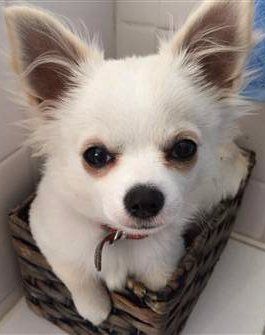When a Chihuahua is Afraid of Everything
Overview
One of the reasons for having a dog is to have a partner, a friend, a companion to be by your side; when you head out for a walk or go to various places, you’re never alone. And one of the reasons for choosing a toy breed is that it’s easier than ever to bring your little dog with you.
So, what happens if you find that your Chihuahua is scared of just about everything? It can make things exceedingly difficult. And for many owners, if a Chihuahua is scared of literally everything – cars, other people, etc. just bringing him for his daily walk can be trying. In addition, if a puppy or dog is scared of the brush, water, being touched, this can make caring for the dog nearly impossible.
This section will cover all the basics of helping a fearful Chihuahua and we will end with tips specifically for adopted rescue dogs.
Please note: PetChiDog is reader-supported. Some of the product suggestions on this page are affiliate links. As an Amazon Associate we earn from qualifying purchases. This is at no extra cost to you and helps keep this site running.
Signs of Being Afraid
It’s not hard to miss most of these signs; however, some can be mistaken for other issues:
Brady, at 6 months old
Photo courtesy of Christine Hart
Is it Normal for Chihuahuas to Act Afraid?
Common Fears
While a puppy or dog can be afraid of just about anything, most typically this breed will be scared of cars, people outside of the household, and of other dogs.
Being wary of other dogs is not necessarily a bad thing; it is valid in some cases. While it is nice for a dog to be able to play with others, unless you fully know and trust a larger dog, we recommend that a Chihuahua only play with dogs of a similar size. Far too many Chihuahuas have been attacked by larger dogs at dog parks that did not have separate areas based on size.
Fear Developing at Certain Ages
There are 2 particular ages in which fear can develop to the surprise of many owners:
3 to 4 months. It is normal for a puppy to appear fearless when very young and then become rather skittish around the 3 to 4-month mark. Why? When a pup is at 7, 8, 9 weeks old, he is not 100% cognizant of the world around him. He may appear to be just fine when picked up, handled, meeting all sorts of people, etc. However, as he matures a bit more but is still young, he gradually starts to be more aware of what’s happening around him.
Now, he is thinking, “Who is this picking me up? I don’t know him!” or ‘Wow, those cars are noisy and scary!”. His eyes are fully open to his environment and everything can suddenly seem terrifying.
10+ years old. Most people assume that older, senior dogs
are going to be really laid back. They’ve seen it all, heard it all and nothing fazes them. However, this is not always the case. There are senior related issues such as hearing loss, decreased vision, canine cognitive dysfunction and/or less tolerance for commotion that can cause a senior Chihuahua to start to act afraid.
Issues to Rule Out if a Chihuahua Acts Afraid
Health issues
– If a normally happy, calm, and friendly Chihuahua suddenly becomes fearful, this can point to a health issue that is causing him to feel ill or in pain. Change in behavior is a red flag for a large majority of conditions. Dogs react in a variety of ways, some may
become clingy, want to retreat, and/or start to hide.
Senior issues
– All seniors should be seen for wellness checks at the vet twice per year. However, even if your Chihuahua just had a visit, something that was borderline and not showing up on tests may have just crossed that line. Have hearing, vision, cognitive abilities, and all health issues ruled out.
How to Help a Chihuahua That is Fearful of Everything
This requires a purposeful, gradual introduction and exposure to triggers. There are some vital things to keep in mind:
1) Some dogs simply cannot overcome a certain fear.
In cases of abuse and other severe circumstances, a dog may not be able to work through his anxiety. Emotional scars can last a lifetime, even if a dog is far removed from his past.
While you should not automatically assume that a fear will last a lifetime, do show understanding if a Chihuahua simply cannot tolerate a particular trigger. Forcing exposure may do more harm than good and can exasperate things. For these such instances, avoidance is best.
In addition, it is near impossible to stop a dog from being afraid of thunder & lightening and fireworks. The first is due to changes in air pressure and noise and the second, of course is the noise.
With senses, including hearing, vastly superior to us humans, a dog cannot be trained to ‘un-hear’. In these cases, the use of a thunder-vest works well. It’s hard to find ones that are actually sized small enough for this breed; however, the ThunderShirt Classic Dog Anxiety Jacket
 comes in size extra-extra small and fits dogs under 7 lbs.
comes in size extra-extra small and fits dogs under 7 lbs.
2) Organize and prioritize.
If your Chihuahua is afraid of a lot of things, taking on too many triggers at once will be stressful for you and counterproductive for your Chihuahua. It's best to conquer fears one at a time.
3) Start with the ‘easy’ ones. Dogs can be afraid of normal household noises; this happens most often if a breeder
did not introduce these elements to the puppy. This may include being afraid of the sound of the vacuum, sink disposal, etc. Anything that can be worked on at home or from home, such as walking passed dogs or walking beside traffic would be on this level.
4) Be sure that everyone in the household is on board.
When one fear is chosen to be conquered and you’ll be slowly allowing your Chihuahua to become accustomed to it, all of the training will go out of the window if another family member is not following along with this plan as well.
Training a Chihuahua to Overcome Fears
Now that you’ve narrowed down what your Chihuahua is afraid of (even if that list seems long and contains just about everything), you realize that some things may be better left alone, and you’ve decided what to work on, the following tips can help.
1) The goal is to expose your Chihuahua to the trigger in a non-threatening, non-forceful way.
In some instances, he can simply start off as an observer. As he gains confidence that nothing bad will actually happen, you can bring him closer to the action.
2) Work with your Chi every day, if possible. At the very least, 3 times per week will be needed.
3) Sessions should start off very short.
Depending on the fear, just 5 minutes may be appropriate. Each week, add on 5 minutes.
5) If at any time your Chihuahua is handling himself well, reward him immediately.
You should not take time to fish into your pocket or go searching for the treat. Have some ready in a sealed, zipped plastic bag for easy distribution.
Note that the treat should not be something that is given at any rate. It should be special and reserved just for this training. Moist treats are best, and you'll want them to be small so that they do not interfere with your Chi's appetite. As always, these should be 100% all-natural with no synthetic preservatives, artificial coloring, and should not have fillers such as corn, soy, or wheat.
A good choice for training treats is Wellbites Soft & Chewy Training Treats ; and if your Chihuahua is very tiny, you can tear one into two pieces.
; and if your Chihuahua is very tiny, you can tear one into two pieces.
6) For any outside training, keep your Chihuahua on a harness.
This allows you better control, but most importantly, part of this training is for you to keep walking or performing an action while ignoring any whining/barking/refusal to move, and with your Chi on a harness and not a collar, this allows you to continue on (slowly yet assuredly) without harming him or causing injury to his neck.
A great harness that fits even tiny Chihuahuas is the EcoBark Maximum Comfort & Control Dog Harness ; the extra-small fits dogs as small as a 7.5 inch neck.
; the extra-small fits dogs as small as a 7.5 inch neck.
7) Exude confidence.
All dogs, but particularly the Chihuahua, are amazingly adept at picking up on their owner’s cues. If you feel nervous that something is going to set your Chihuahua off (even if you do not voice that opinion), your Chihuahua will know.
Your dog will know this based on your non-verbal cues such as body language and facial expression.
While holding sessions, your role is to act in a matter-of-fact way, to ‘prove’ that there is nothing worth being afraid of and to not react to any fear-based physical actions or verbalization that your dog may be displaying.
If we go back to the example of a Chihuahua being afraid of cars, it works like this: Starting at a low-intensity level of a walking route with very few cars, when a car eventually passes by, do not tense up in anticipation. Continue walking. Your Chihuahua may attempt to plant himself down firmly or try to lie down.
This is one reason the harness comes in handy. Keeping the same steady pace, continue walking, as if you are completely and utterly unaware that your dog is attempting to either stay still or drop down. With the harness displacing pressure across the back, shoulders, and chest (and not the neck as a collar would) you will cause no harm to him as long as you do not run…. Just walk at the normal pace that you established as your walk began.
If your puppy whines, talk out loud in a matter-of-fact manner (the subject can be anything at all; you’ll just want your dog to hear your nonchalant voice). Your goal is to entirely act as if you do not notice any change in your dog’s behavior. You will want to continue on as if the car was so unimportant, it did not warrant your attention.
As the car drives by and is then gone from sight, your Chi is going to become confused for a moment. However, seeing that you were not affected, he will start to question as to whether he should be affected. Done enough times, a dog will start to re-think his actions. Done some more, a dog will not only consider copying your behavior but actually do so.
8) Set small goals and celebrate them.
Maybe your first goal is for your Chihuahua to stay to your side for security instead of running to hide in a closet. Or maybe a great step is for your dog to quietly watch dogs playing, and while he is not jumping in to join them at least he is not cowering.
There are both steps in the right direction. Reward for them, be proud of your Chi, and be patient as you reach for the next level of acceptance.
*** Would you like more detailed, step-by-step training guidelines? For complete chapters on fear of people, other dogs, and cars, you may wish to obtain The GIANT Book of Chihuahua Care, available in both hard copy print and eBook.
Tips for Very Fearful Rescue Dogs
Even if you know the basic background of a shelter dog, it’s nearly impossible to truly know what that dog lived through that may have left emotional scars. Here are some tips to keep in mind:
1)
The oddest things can be scary to a formerly abused dog; such as just a specific type of person (this can be gender related or even height), certain rooms (dark rooms such as the garage or small rooms such as the bathroom) or typical care elements such as baths or brushing that the neglected dog was never able to become used to.
Photo courtesy of Juliane Ruff,
Highland Park IL
Time and patience are needed and do use your judgement; in some cases, catering to a certain fear is not necessarily enabling it; it is just the kind, logical thing to do.
2)
Do not take it personally if your Chihuahua seems afraid of you. For some dogs, the person who was their ‘leader’ was the one that inflicted pain and suffering. It can take a while for a dog to learn that his human is a good one. This can be overcome. When there are more new, good experiences than there are bad ones, there will be a gradual transition to a new life.
Remember, some sources say that dogs do not have good memories. But this is not really true. They have trouble with short-term memory. However, when something is repeated often enough (such as commands, house training, etc.) it then moves from short to long-term memory.
And it stays there, as long as it is reiterated once in a while. So, if a dog was treated in such a way to induce fear, those memories are going to stay for a white. BUT, as long as the treatment is NOT reiterated, they will fade away.
3) Give what is really craved, compromise on some things, and be firm with others. If a rescue dog feels best when he makes a little nest for himself in a closet or if he only eats once everyone leaves the kitchen, allow him that as long as it does not interfere or conflict with your own needs.
For other elements, compromise; perhaps your Chihuahua does well with a few visitors but cannot handle large crowds; you can have him out to meet & greet when there are just a couple of guests over, but have him safe and sound in his canine playpen
if you have a large gathering.
And when it comes to care necessities such as bathing, brushing, nails, etc. you’ll need to perform these for both hygiene and health reasons. Most dogs do best when these tasks are done on a schedule (they will start to learn what to expect) and in an area that is calm and relaxing for both owner and dog.
Things you may wish to do now:
Become a free PetChiDog Member
- You will be able to receive friendly reminders when we add new pages to the site. You will also be able to suggest a topic for us to write about. * If you are already a Member, just reply to any newsletter with your idea.
Check out the Chihuahua Supplies
page, which lists out all recommended items for a variety of care needs.






